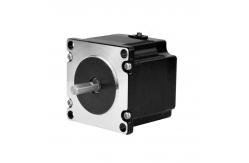57HS064 Series 2 Phase Hybrid Stepper Motors
|
|
1. Product Overview Step motor is a motor that converts the electrical pulse signal into the corresponding angle displacement or the line displacement. It can use the quantity and frequency of the pulse to control the rotation (rotation angle, rotation speed) in automation applications. For each of the pulse, the motor rotor rotates a angle or forward, and its output angle shift or line displacement is proportional to the input pulse, and the speed is proportional to the pulse frequency. Therefore, step motor is also called pulse motor. In the case of non-overload, the speed of the motor and the stop position depends only on the frequency and number of the pulsed input, without being affected by the load change. That is to say, add a pulse signal to the motor, and the motor turns a step distance. The advantage of this linear relationship between pulse and angle rotation, plus that a step motor only has periodic errors without cumulative errors, make step motor widely used in automation speed, position and other control fields easily. With the development of product research and development of technology, the performance of the step system has been even more improved. If the stepper system is not overloaded, there will be no step loss mostly nowadays, and life time very long, almost no need maintenance, which makes steppers popular and widely used in many kinds of industrial automation motion control applications.
Although the stepper motor and its control technology are currently very mature, if not used properly, there may still be a situation of step loss, i.e. position error. Next, we will analyze the common causes and solutions of position errors. The reasons for the position error of stepper motors Large load inertia When the inertia of the load driven by the stepper motor is large, its inertia will generate inertia force, causing the current waveform output by the stepper motor controller to be inconsistent with the actual required current waveform, resulting in inaccurate position of the stepper motor. The stepper motor driver is not set correctly Incorrect settings of the stepper motor driver, such as fine fraction, step angle, and other parameter settings, can also lead to an increase in the position error of the stepper motor. The pulse signal output by the stepper motor controller is unstable When the pulse signal output by the stepper motor controller is unstable, it can lead to inaccurate position of the stepper motor. This situation is more common when using long-distance transmission of control signals. The stepper motor is damaged The rotor or stator of the stepper motor may be damaged, or the bearings may be damaged, which can lead to positional errors in the stepper motor. Methods to solve the position error of stepper motors Control load inertia The position error of the stepper motor can be reduced by reducing the load inertia. For example, when driving a stepper motor with inertia loads, methods such as installing shock absorbers and changing the load inertia mode can be used to reduce the load inertia. Set the driver parameters correctly Correctly set the subdivision and step angle parameters of the stepper motor driver to ensure the position accuracy. Stable output pulse signal High precision pulse generators or adjustable filters can be used to stabilize the output pulse signal and reduce the position error of stepper motors. Replace damaged stepper motor components When the stepper motor is damaged, it is necessary to replace the corresponding components in order to restore the normal operation of the stepper motor.
The Applications of Kaifull PRMCAS Hybrid Stepper Motors
Kaifull hybrid stepper motors are mainly used in digital control systems, with high accuracy and reliable operation. If position detection and speed feedback are used, closed-loop control can also be achieved. Stepper motors have been widely used in digital control systems, such as digital to analog conversion devices, CNC machine tools, computer peripherals, automatic recorders, clocks, etc. In addition, they have also been applied in industrial automation production lines, printing equipment, etc. The application scenarios of Kaifull stepper motors are very wide, and the following are some application examples: Industrial field: Stepper motors are used in automotive instrumentation, machine tool automation production equipment, robot manufacturing, inspection, and process flow. Security field: Used for monitoring products, such as PAN/ZOOM/TILT for security cameras. Medical field; Hydraulic pumps, ventilators, and blood analyzers used in medical scanners, samplers, digital oral photography. In the field of consumer electronics, it is used in various stages of electronic product production, such as solder paste printing, SMT placement, reflow soldering, visual inspection, production of cables with terminals, dispensing machines, screen laminating machines, 3D printers, etc. Precision equipment and instruments: used in ATM machines, inkjet printers, engraving machines, photo machines, spray painting equipment, computer peripherals and massive data storage devices, precision instruments, industrial control information systems, office automation, robots and other fields, especially suitable for applications with smooth operation, low noise, fast response, long service life, and high output torque. Textile machinery: It is widely used in textile machinery equipment such as computerized embroidery machines. These stepper motors have the characteristics of low torque retention, fast response speed, low operating noise, stable operation, good control performance, and low overall cost. Flat mobile devices: such as laser cutting machines, printers, scanners, etc. Measurement instruments: such as high-precision 3D scanners, optical measurement equipment, etc. Medical equipment: used for medical and surgical instruments, etc. Camera lens. Used for focusing and moving optical devices, etc. These application scenarios typically require stepper motors to have characteristics such as high precision, low noise, fast response, and long lifespan to meet the positioning, control, and performance requirements of different industries.
2. Hybrid Stepper Motor General Technical Specifications
3. Hybrid Stepper motor Performance Datasheet
4. Mechanical Dimensions (in mm)
5. Wiring Diagram
6. Torque Speed Curves
|
||||||||||||||||||||||||||||||||||||||||||||||||||||||||||||||||||||||||||||||||||
| Product Tags: 57HS064 Series Hybrid Stepper Motors |
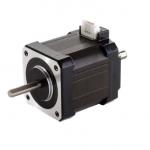
|
6 Wire 2 Phase Stepper Hybrid Motor Nema 17 Dual Shaft Stepper Motor |

|
2 Phase Single Shaft High Speed Stepper Motor Hybrid Nema 23 6 Wire Stepper Motor |
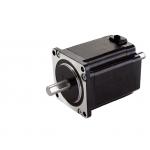
|
57AHS240 Hybrid Nema 23 Dual Shaft Stepper Motor Four Wires 2 Phase Stepper Motor |
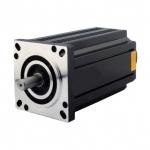
|
6 Wire Hybrid Three Phase Stepper Motor Nema 52 130mm 3130AHS3500 |
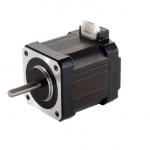
|
Hybrid High Speed Nema 17 Stepper Motor 6 Wire 2 Phase 42AHS031/043 |
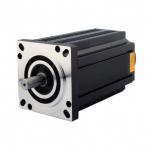
|
Hybrid 3 Phase Stepper Motor 130mm Nema 52 Stepper Motor 3130AHS2800 |

